Featured Application
This research provides a new technical route for grid-connected photovoltaic plants in high-altitude regions and provides an essential theoretical basis for developing power generation systems based on hot dry rock (HDR) geothermal energy.
Abstract
Hot dry rock (HDR) power stations have the potential to serve as an energy storage system for large-scale photovoltaic (PV) plants. For flexible operation, thermal storage (TS) power stations are required to coordinate with HDR power stations. In this study, a hybrid power system is constructed by combining the HDR, TS, and PV plants. Game theory is then introduced into the optimal dispatch of the hybrid power system. Considering HDR, TS, and PV as players, non-cooperative and cooperative game dispatching models are established and verified by a case in the Gonghe basin of Qinghai. Finally, the stability of the coalitions and the rationality of allocation of the hybrid power system is verified, and the sensitivity of critical parameters is analyzed. The results demonstrate that the overall payoff of the hybrid power system is increased by 10.15%. The payoff of the HDR power station is increased by 16.5%. The TS power station has obtained 50% of the total extra profits. The PV plant reduces the impact on the grid to obtain the priority of grid connection. Based on these results, a theoretical basis can be provided for developing generation systems based on the HDR resources in the Gonghe Basin.
1. Introduction
With the increasing clean energy penetration, the power grid’s security, stability, and economy have been severely affected by the intermittent and fluctuating nature of power sources. The large-scale transmission and consumption of clean energy face the challenge of a shortage of reliable power sources. This issue is especially prominent for some clean energy bases where clean energy production and transmission are the primary industry [1], such as the Gonghe Basin. This region has tens of millions of kilowatt-level clean energy bases with abundant wind, solar, hydropower, and geothermal power resources. However, because of the lack of flexible and stable power sources, it is difficult to expand the scale of clean energy development further.
Among the various types of clean energy sources, hot dry rock (HDR) power stations have the most stable and reliable operational characteristics [2]. The development of a more flexible operational mode to form a new type of energy storage system, coupled with the vast amount of thermal energy in the geothermal reservoir, would be instrumental to ensure the reliability of grid-connected photovoltaic (PV) plants and to support clean energy transmission. In [3], geophysical methods were used for geological characterization of the Gonghe Basin on different scales. Finally, the scope and volume of Gonghe HDR resources were evaluated. According to preliminary estimates, the amount of HDR geothermal energy in the Gonghe Basin is equivalent to 55.909 billion tons of standard coal [4]. Considering environmental protection requirements and realization of carbon neutrality constraints [5], comprehensive utilization of HDR geothermal energy will become an essential aspect of the global clean energy supply.
However, the large-scale development of HDR resources still faces several technical and cost constraints [6]. The experimental results and the critical technical challenges of HDR geothermal energy development were summarized in [7]. The hydraulic fracturing method assisted by micro-computed tomography was addressed in [8], which improved the development of HDR geothermal resources. Focusing on the geothermal resources of HDR in Daqing oilfield, China, the research carried out a numerical simulation on reservoir stimulation and economic analysis of HDR power stations [9]. The results show that economy is key for restricting the development of HDR geothermal resources. The geothermal generators in the HDR power stations have low theoretical efficiency limited by the HDR temperature [10]. In order to improve the economics of low-temperature HDR power stations, the energy efficiency and exergy loss of the Kalina cycle were analyzed in detail, and the maximum energy efficiency of 12.7% was obtained [11]. In [12], the adaptability of the organic Rankine cycle (ORC) and Kalina cycle in low-temperature HDR scenarios were further compared and analyzed. The energy efficiency of the geothermal generator was increased to 13.2%. Previous studies have shown that research in improving the efficiency of HDR power station has been lagging owing to the limitations of physical and chemical properties. Therefore, coordinated operation of hybrid power systems with other energy sources, such as PV plants, provides a new technical path for HDR power stations to exploit their potential better and reap better economic benefits.
Extensive research has been conducted by scholars worldwide on the coordinated operation of hybrid power systems [13]. Some studies have been conducted from the perspective of complementation. In [14], a stochastic two-stage unit commitment model and a rolling look-ahead economic dispatch model were established based on the concentrated solar power plant and the wind turbine complementation mechanism. To further improve the reliability of the hybrid power systems, the robust optimization theory was introduced into the optimization dispatch for a hybrid wind-PV-hydropower-thermal system to balance reliability and economy [15]. Considering the scenario of time-of-use (TOU) electricity price and randomness of wind power, a stochastic hourly combinational approach for effective dispatching of the wind plants, cascaded hydropower station, and pumped-storage units was proposed in [16].
With the development of electrochemical energy storage technology, batteries have been widely used to coordinate renewable energy systems [17]. A linear model was used to describe the energy storage dispatching model that minimized the power demand and verified the feasibility of lithium-ion battery storage [18]. In [19], the load following strategy and cycle charging strategy of battery are combined to explore the feasibility of a joint dispatching strategy for PV/diesel/battery hybrid power system. A model for optimizing AC-coupled and DC-coupled PV-battery hybrid power system was proposed in [20], which proved the economics of large-scale lithium battery storage plants under appropriate conditions.
The research on geothermal hybrid power systems is still relatively few. Geothermal generation was used as the power source to optimize the dispatch of wind- PV hybrid power system in the island scenario [21]. An HDR power station scheme combining geothermal generation, absorption refrigeration, and waste heat heating systems was further proposed in [22]. For specific applications, an HDR cogeneration system that combines wind and PV energy as power sources to meet the cold, heat, and electricity demands of an independent micro-energy grid was proposed in [23]. In [24], a new type of combined cooling and power supply system was proposed in order to meet the energy demand of buildings, which can meet the seasonal cooling and power demand of buildings and maximize the utilization of hot dry rock resources.
The above research can well solve the coordinated dispatching problem and improve the system economy, but the interaction of the hybrid power system participants is not entirely reflected [25]. Therefore, other scholars have discussed the hybrid power system’s coordinated operation based on game theory [26]. In [27], game theory was introduced to model a hybrid power system comprising wind turbines, PV plants, and batteries to optimize the dispatching strategy of energy storage systems. The Stackelberg game was used to obtain the charging strategy of electric vehicles and the pricing strategy of charging stations [28]. Cooperative and non-cooperative game methods were used to study automatic distributed optimal economic of automatic generation control in multi-region power systems [29]. A non-cooperative game dispatching model composed of wind power, thermal power, and pumped storage power plants was established to optimize the combined operation effects in different seasons [30]. Through non-cooperative game theory, a power generation dispatch model of a hybrid power system containing wind, wind, and heat was established to maximize the overall profits in the long-distance transmission scenario [31]. A general framework for power system flexibility analysis based on cooperative game theory was proposed for risk design and energy policy design [32]. The potential cooperative behaviors of multiple grid-connected micro-grids were simulated to achieve higher efficiency and better economy [33]. In [34], the payoffs of wind turbines, thermal power stations, and electric vehicles in the power market were studied based on cooperative game theory, and the imputation of the cooperative game was rationally allocated based on the Shapley value. The profit allocation of the hybrid power system in the cooperative game was analyzed in [35]. The results show that the Shapley value is the most stable allocation strategy.
Previous studies have provided extensive theories and methods for the hybrid power system dispatching. However, the characteristics of HDR power stations observed in the energy extraction and conversion process lead to different operational strategies compared to thermal power stations and energy storage power stations. The existing coordinated dispatching models and payoff allocation mechanisms for multi-energy sources are not entirely suitable for HDR power stations. Accordingly, the coordinated operation model and payoff allocation strategy for HDR power stations require further research.
Therefore, the major contributions of this paper are: (1) a new method for designing HDR power stations is presented to reduce the power fluctuations of PV plants and improve the reliability of the power grid; (2) a hybrid power system composed of HDR, TS, and PV plants is constructed, and the coordinated operational characteristics of HDR power stations in the hybrid power system are analyzed; (3) a game pattern with HDR power stations, TS power stations, and PV plants as players is proposed. The non-cooperative game’s payoff function and the characteristic function of the cooperative game are then defined; and (4) the game dispatching models are simulated with the case of the Gonghe Basin of Qinghai. Finally, a sensitivity analysis of the two critical parameters of the allowed fluctuation rate, and the penalty coefficient is carried out.
The remainder of this paper is organized as follows. The architecture of the HDR-TS-PV hybrid power system and characteristics of the HDR power station are given in Section 2. The HDR-TS-PV game model is proposed in Section 3. Section 4 simulates a case based on actual data of the Gonghe Basin. An in-depth discussion of the simulation results is carried out in Section 5. Conclusions and further developments are discussed in Section 6.
2. HDR-TS-PV Hybrid Power System Architecture
2.1. Architecture of the Hybrid Power System
Conventional HDR power stations include geothermal mining cycles and ORC generators [36]. Because the extraction of geothermal energy from artificial reservoirs established by hydraulic fracturing requires a bottom hole pressure of 30 MPa to 40 MPa and a pipeline that is 3 km to 4 km deep [37] and considering the working fluid velocity and the rock elastic modulus, the dynamic response time of the geothermal mining cycle is especially high. Although the annual utilization time can exceed 8000 h, the flexibility of HDR power stations is not sufficient to fully exploit the energy storage effect of the reservoirs to provide reliable support for PV plants.
Therefore, it is necessary to design a TS power station that can be coordinated with HDR power stations to improve operational flexibility. The TS power station comprised a thermal energy storage exchanger (TESE), a thermal energy storage tank, an ORC generator, and an electric heating device. The heat-transfer oil (HTO) was used as the thermal energy storage medium. The TS power station can use the TESE to store the waste heat from the HDR power station and convert the surplus power from PV plants into thermal energy through the electric heating device.
Conversely, conventional battery energy storage stations cannot adapt to the Qinghai plateau’s cold climate, have a short cycle life, and cannot directly use geothermal energy. Nevertheless, the TS power station is not affected by environmental conditions; it demonstrates the flexible operation of the battery energy storage stations and can store geothermal energy directly, making it suitable for a hybrid power system with an HDR power station.
The hybrid power system of the Gonghe Basin was considered as a test case for this research. The region has a plateau continental climate with large temperature variations and experiences rapid changes in weather conditions throughout the day. Although solar energy resources are abundant, the local loads are insufficient and require a large amount of PV power to be transmitted for consumption. Therefore, the local government has formulated a policy that renewable energy power stations should be equipped with energy storage systems with a capacity of 5% to 10%. An HDR-TS-PV hybrid power system architecture was constructed with a typical 200 MWp PV plant equipped with an HDR power station and a TS power station, as shown in Figure 1.
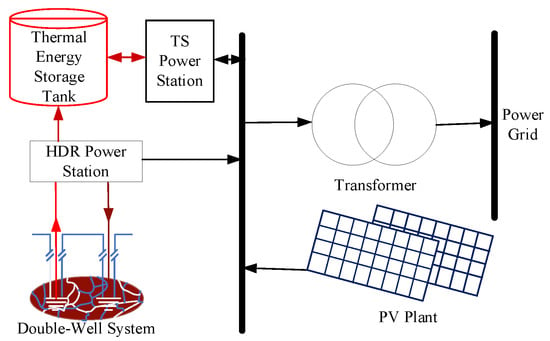
Figure 1.
Architecture of the hybrid power system.
As Figure 1 shows, the HDR power station was designed according to the temperature of the HDR source, which was calculated considering the optimal working fluid flow and the power generation efficiency given in [11], and its capacity was set at 6.6 MW. The TS power station was coordinated with the HDR power station, whose capacity was also set at 6.6 MW. The HDR-TS-PV hybrid power system improves the operational flexibility and economy of the HDR power station through the adjustable TS power station and simultaneously enhances the reliability of the PV plant. In this hybrid power system, the HDR power station, TS power station, and PV plant are connected to the low voltage side of the same transformer. To coordinate the operation of the three elements, this study makes the following assumptions:
- The HDR power station is a standard double-well system [4];
- The effects of network congestion and line capacity on the system are ignored;
- The TOU price is regulated by the power selling side.
2.2. Operating Characteristics of HDR Power Station in Hybrid Power System
The HDR power station, as shown in Figure 2, is composed of a geothermal mining cycle and ORC generator, coupled with a heater. The geothermal mining cycle consists of underground HDR fracture channels, a production well, a reinjection well, a circulating pump, and the heater. The brine is driven by the circulating pump from the reinjection well into the underground HDR fracture channels to absorb geothermal energy, then from the production well into the heater to release the heat and re-enter the reinjection well.
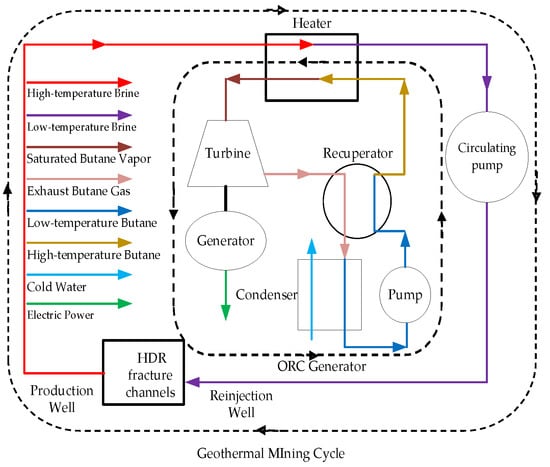
Figure 2.
Structure chart of the hot dry rock (HDR) power station.
The ORC generator includes the heater, a recuperator, a turbine, a condenser, a generator, and a pump. The liquid organic working fluid butane is driven by the pump to enter the heater for absorbing the heat released by the brine. The butane with the saturated vapor state then enters the turbine to expand and convert heat into mechanical energy. The residual energy still contained in the exhaust butane gas is transferred to the low-temperature liquid butane through the recuperator. The exhaust butane gas finally condenses into the low-temperature liquid butane in the condenser and then enters the next cycle again. A more detailed discussion of the ORC could be found in [38].
Several days are required for the HDR power station to establish a stable geothermal mining cycle, and a similar period is required to adjust the geothermal working fluid pressure and flow rate, and the fluid used is usually brine. Therefore, compared to thermal power plants, the power ramp rate of conventional HDR power stations is low, and frequent start and stop cannot be achieved. In the actual operation, the HDR power station consistently maintains its geothermal mining cycle by alternately configuring two circulating pumps. This feature further urges the ORC generators to continuously generate electricity in order to fully exploit the geothermal energy for higher economic benefits. The continuous power generation model of a conventional HDR power station [12] is
where represents the output power, is the mass flow of brine, is the specific heat capacity of brine, and is the ORC generator’s efficiency. and represent the outlet temperature of the production well and the temperature of the reinjection well, respectively.
It should be noted that under the hybrid power system architecture shown in Figure 1, part of the continuous geothermal energy generated by the geothermal mining cycle can be stored in the thermal energy storage tank through the TESE so that the geothermal energy flow is decoupled from the electrical energy flow of the ORC generator. Therefore, the HDR power station can fully utilize the fast adjustment speed and wide range of operating conditions of the ORC generator to provide reserves without losing geothermal energy. The flexible power generation model of the HDR power station can be expressed as follows:
where Equation (2) represents the model of the brine distribution, represents the mass of the brine used for power generation, and represents the brine used for thermal energy storage. is the thermal power input to the TESE in Equation (3), and represents the waste heat temperature of the brine after TESE. The output power of the HDR power station can then be described by Equation (4), where, represents the output power.
3. HDR-TS-PV Game Model
3.1. ElemenTS of the Game
Compared with other coordinated dispatching methods, game theory can better clarify the internal mechanisms of multi-agent competition and cooperation to quantify each party’s benefits. The elements of the game include Player, Strategy, and Payoff.
- 1
- Player
The HDR power station, TS power station, and PV plant are the three players, denoted by H, T, and P, respectively.
- 2
- Strategy
The operational goal of the HDR power station is to obtain as much profit as possible to rapidly recoup the high costs of construction by changing the mass flow of brine to dispatch the power. Therefore, the strategy set of the HDR power station is
where represents the installed capacity of the HDR power station, and is the output power that meets the minimum power generation requirements of the ORC generator, which is generally 10% of the installed capacity.
The TS power station primarily realizes the arbitrage of the electricity price peak-valley difference by dispatching purchased power and generating power. Therefore, the strategy set of the TS power station is
where is the electric power purchased from the grid during the low TOU price period and limited by the maximum power of the electric heating device. represents the power generation capacity of the TS power station, and its upper and lower limits are the installed capacity and the ORC generator and the minimum power generation condition , respectively.
The operational goal of a PV plant is to formulate a credible output power plan based on the weather forecast data to increase the credible capacity connected to the grid as much as possible so as to reduce the loss of surplus power and penalty incurred by abandoning loads. its strategy set is
where is the credible output power of the PV plant, and its corresponding installed capacity is the credible capacity of the PV plant, denoted by . represents the installed capacity of the PV plant.
- 3
- Payoff
All three players profit by selling electricity to the grid so that we can define the payoff vector of the game as
where , and represent the payoff of the HDR power station, TS power station, and PV plant, respectively.
Each player has an independent and equal status and can either compete in a non-cooperative game or try to increase profits through cooperation. The coordination dispatching models of the two types of games are given below.
3.2. HDR-TS-PV Non-Cooperative Game and Payoff Functions
If all three players are independent and try to maximize their profits, they naturally constitute a non-cooperative game of competition with each other. This paper first presents the payoff functions of the three players in non-cooperative games in order to compare and analyze the results of the subsequent cooperative game dispatching model.
3.2.1. Payoff Function of HDR Power Station
Owing to the continuity of the geothermal mining cycle, the brine mass flow of the HDR power station cannot be adjusted in the non-cooperative game in order to avoid heat loss. The flexibility of the ORC generator cannot be fully utilized, and only the continuous power generation mode can be adopted. Therefore, according to Equation (1), the payoff function of the HDR power station is
3.2.2. Payoff Function of TS Power Station
In the non-cooperative game, the TS power station purchases electricity from the power grid during the low TOU price period and converts it into thermal energy. During the high TOU price period, the TS power station generates electricity for arbitrage. The payoff function is
The output power of the TS power station to the power grid can be modeled as
where is the mass flow of the HTO during the power generation period and is the specific heat capacity of the HTO. and represent the temperature of the HTO used for power generation and its temperature after power generation, respectively.
The operation of the TS power station must also account for the following thermal storage state constraints and thermal energy store/release constraints:
where is the thermal storage energy in the tank, is the input thermal power when the TS power station is storing thermal energy, is the released thermal power, is the thermal preservation coefficient of the thermal energy storage tank, is the efficiency of the thermal release process, is the electric heating efficiency, and is the time interval.
3.2.3. Payoff Function of PV Plant
The output power of the PV plants can be modeled using solar irradiance and the installed capacity [39]. According to the weather forecast, the PV plant obtains the predicted output power as the credible power generation in the first stage. The curtailed electricity and the abandoned loads are obtained from the actual solar irradiance in the second stage. This type of problem can usually be described by a Bayesian game model [34]: the two players of the game are the PV plants and nature, where the PV plants make decisions based on predicted values, and nature determines the joint probability of the actual solar irradiance. The payoff function of the PV plant is
where is the number of types of solar irradiance, is the probability of each type, represents the predicted value of the output power based on the solar irradiance in the non-cooperative game. and are the curtailed power and the abandoned loads under each type, and is the penalty price for abandoned loads. The models of , , and are
where is the power generation coefficient of the PV plant predicted according to the solar irradiance [39] and is the actual output power corresponding to the non-cooperative part of the PV plant. is the power predicted error of the PV plant.
The penalty price for abandoning loads, is expressed as the product of the penalty coefficient for abandoning loads and the TOU price , namely,
3.3. HDR-TS-PV Cooperation Game Pattern
If the three players in the hybrid power system intend to form coalitions, such as coordinated dispatching with a PV plant, the HDR power station can obtain greater benefits by providing auxiliary services and by the coordinated dispatching with a TS power station, and the HDR power station can use the TOU prices for arbitrage. The three players participate in cooperation under these conditions. Due to the limitations caused by the efficiency of the ORC generator, it is difficult for the TS power stations to profit from the TOU prices. Therefore, the TS power stations need to cooperate with the HDR power station or the PV plant to profit from waste geothermal or surplus PV power with zero marginal costs. Concurrently, because of the requirements of power grid assessment for the PV curtailment power and the abandonment load, the PV plant also cooperates in order to reduce the loss of the curtailed power and the penalty for abandoning the load.
It is observed that through cooperation, the three players can obtain a greater payoff and allocate extra profits through energy settlement, which is only related to the cooperating players. Therefore, cooperation between HDR, TS, and PV can be modeled by the characteristic function game (CFG). CFG uses the tuple to describe the cooperative game relationship, where is a set representing the number of players in the coalition. represents the characteristic function that reflects the payoff of the coalition, which is represented by the mapping relationship . For any of , or represents the overall payoff of the coalition.
In the cooperative game, the three players can form four different coalitions denoted by [{H, T}, {P}], [{H, P}, {T}], [{P, T}, {H}], and [{H, T, P}]. The payoff of the players is defined by the tuple , where is the coalition structure and is the payoff vector. must meet the individual rationality
where is the payoff received by the player in the coalition, and represents the payoff of the player in the non-cooperative game.
3.4. Characteristic Functions of HDR-TS-PV Cooperative Game
In the non-cooperative game, each player can only achieve their best profits through their independent dispatching strategies. By forming coalitions, players have more options for coordinated dispatching, thus expanding the strategy set. Based on the original profit model, HDR and TS power stations can also profit by providing reserves for the PV plant, but their primary strategies are to dispatch output power. Therefore, the strategy sets of the HDR and TS power stations are still and , respectively. The PV plant can reduce the curtailed power and penalty for abandoning the load by purchasing reserves; therefore, its strategy set also includes
where represents the reserves purchased by the PV plant, and represents the power fluctuation rate allowed by the grid. In the case of purchasing the reserves, the constraint in Equation (22) always limits the PV plant’s output power within a range of around the predicted value. Therefore, can be considered as the credible output power of the PV plant, and its corresponding installed capacity is the credible capacity of the PV plant, denoted by . represents the actual output power corresponding to the credible capacity part of the PV plant.
Because the actual installed capacity of the PV plant may be greater than the reserve capacity provided by the HDR power station, the installed capacity can be divided into non-cooperative and cooperative parts in the cooperative game.
In a non-cooperative game, the players cannot use their respective resource characteristics and operating modes to achieve complementary advantages. Through cooperation, players can fully coordinate the dispatching of resources to maximize profits. The operating models and the profit models can be innovated to expand payoff sources, thereby increasing the overall payoff of the hybrid power system. The characteristic function of each coalition is described below.
3.4.1. Characteristic Function of HDR-TS Coalition
In the HDR-TS coalition, the TS power station stores part of the HDR geothermal mining cycle’s thermal energy in the low TOU price periods and then reuses the stored thermal energy to generate power in the high TOU price periods for arbitrage. The characteristic function of the HDR-TS coalition is
According to the flexible generation model of the HDR power station described in Equations (2)–(4), the heat exchange constraints for the TS power station to obtain geothermal energy from the HDR power station are
where represents the thermal energy storage temperature of the HTO, represents the waste heat power of the HDR power station, and is the heat exchange efficiency of the TESE. Additionally, the constraints of the optimization problem Equation (24) also include Equations (1), (12) and (14).
3.4.2. Characteristic Function of HDR-PV Coalition
In the HDR-PV coalition, the HDR station flexibly distributes the mass flow of the brine to provide reserves for the PV plant, which can then increase the overall payoff of the coalition by reducing the curtailment power and penalty for abandoning loads. The characteristic function of the HDR-PV coalition is
where represents the payoff of the non-cooperative game part of the PV plant, which is calculated according to Equation (15).
The reserve dispatching constraints for the HDR-PV coalition are
where represents the reserves provided by the HDR power station, and is the brine mass flow required when the reserves are dispatched.
3.4.3. Characteristic Function of TS-PV Coalition
In the TS-PV coalition, the TS power station converts the electricity purchased from the grid during the low TOU price periods and the surplus PV power into thermal energy for storage. During the high TOU price periods or shortage periods of the PV plant, the stored thermal energy is used to generate revenue and provide reserves for the PV plant. The TS power station achieves profitability through the zero-cost electricity generated by the surplus PV power. Simultaneously, the PV plant increases its credible capacity and reduces the penalty for abandoning loads by purchasing reserves, thus forming a cooperative game pattern. The characteristic function of the TS-PV coalition is
The TS power station provides an up-reserve through the ORC generator to realize the profits and a down-reserve through electric heating devices to absorb surplus PV power. The reserve constraints of the TS-PV coalition are
where represents the up-reserve provided by the TS power station, is the mass flow of HTO that needs to be adjusted when the up-reserve is dispatched, and represents the surplus PV power consumed when the TS power station provides a down-reserve for the PV plant. The constraints also include Equations (1) and (12).
3.4.4. Characteristic Function of HDR-TS-PV Coalition
When the HDR power station, TS power station, and the PV plant are coordinated for dispatch, the TS power station can store geothermal energy in the thermal energy storage tank for the subsequent generation, which improves the flexibility of the HDR power station and realizes the peak regulation of the geothermal energy. Both the HDR power stations and the TS power stations can simultaneously provide reserves for the plants through flexible output power dispatching strategies, thereby increasing the credible capacity of the PV plant, reducing the curtailment of PV power and the penalty for abandoning loads, and further improving the overall payoffs. The characteristic function of the HDR-TS-PV coalition is
The constraints of the HDR-TS-PV coalition include the operating constraints, thermal storage state constraints, and reserve constraints of their respective systems, including Equations (1)–(4), (12), (25), (28)–(30), (32)–(34). They are not repeated here.
4. Case Study
4.1. System Parameters
Based on the weather conditions in the Gonghe Basin of Qinghai and TOU price, a fictitious hybrid power system was constructed to verify the models and the methods proposed in this paper. In addition to abundant solar energy resources, the Gonghe Basin also has high-quality HDR resources [40,41]. The scenario diagram of the fictitious hybrid power system is shown in Figure 3. The solar irradiance and the TOU price curves are shown in Figure 4.
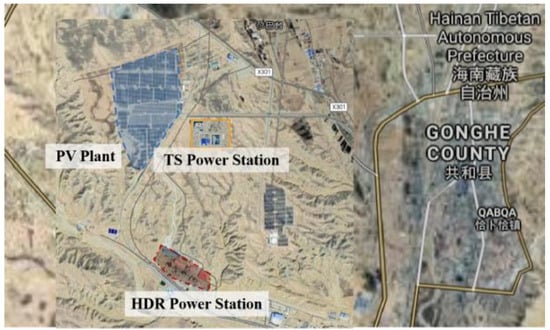
Figure 3.
Scenario diagram of the hybrid power system.
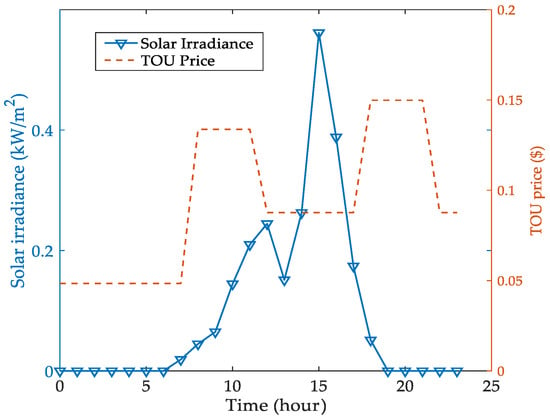
Figure 4.
Solar irradiance and TOU price curve.
The Latin hypercube method [42] is adopted to generate 10,000 scenarios using the actual solar irradiance data, which are finally reduced to 100 typical scenarios [43] as the types observed in nature. The system parameters are listed in Table 1.

Table 1.
System parameters.
4.2. Dispatching Results
Each payoff function and characteristic function is linear programming or mixed-integer linear programming, which was solved by software MATLAB2016b and CPLEX12.8. The results are shown in Table 2.

Table 2.
Dispatching results of cooperative and non-cooperative games.
It can be observed from Table 2 that the payoff of the TS power station is zero because it cannot profit in the non-cooperative game. The payoff of the HDR-PV coalition is lower than the sum of the two non-cooperative game payoffs, i.e.,
These results show that the HDR power station and the PV plant cannot form a stable coalition. Figure 5 shows the results for the coordinated operation of the HDR-PV coalition. The HDR power station provides reserves to increase the credible capacity of the PV plant by replacing geothermal energy with the curtailed power and the abandoned loads. However, the cost of abandoning geothermal energy is greater than the sum of the curtailed power and penalty for abandoning loads. Therefore, the coordinated operation of the HDR power station and PV plant cannot increase the overall payoff, making the HDR-PV coalition unstable.
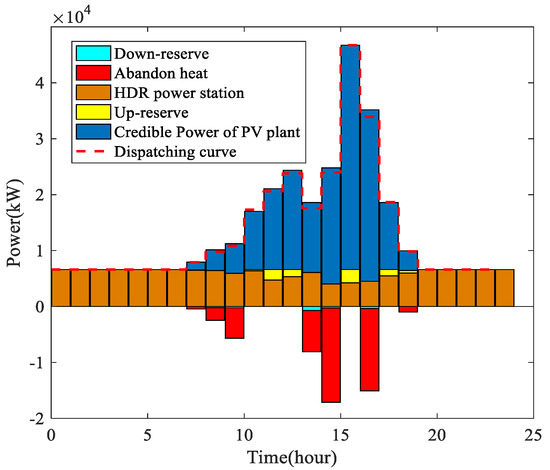
Figure 5.
The coordinated operation of hot dry rock-photovoltaic (HDR-PV) coalition.
When the TS power station joins the HDR-PV coalition to form a grand coalition, the abandoned geothermal energy used to stabilize the fluctuation of the PV plant is reused by the TS power station to generate new profits. The results of the grand coalition cooperative game dispatching are shown in Figure 6. During the low TOU price period (0:00–7:00), both the HDR and TS power stations maintain minimum output power. The continuous geothermal energy is stored in the thermal energy storage tank of the TS power station while ensuring the safety of the geothermal mining cycle. During the PV generation period (8:00–18:00), the HDR and TS power stations provide reserves corresponding to the credible output power of the PV plant. The HDR power station is then operated at full power to maximize profits. The TS power station converts all the stored thermal energy into electricity during the high TOU price period (19:00–22:00).
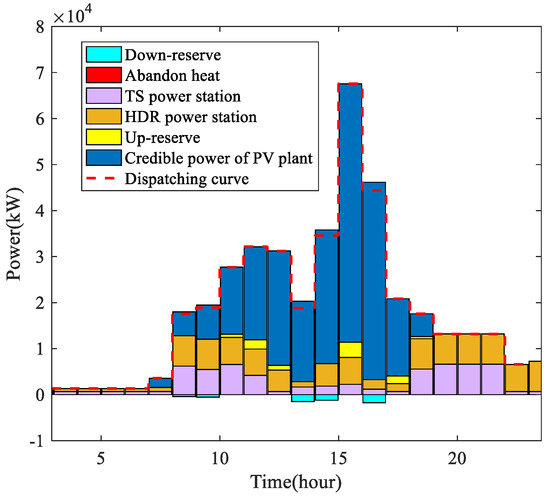
Figure 6.
The coordinated operation of hot dry rock-thermal storage-photovoltaic (HDR-TS-PV) coalition.
In the end, the three players tend to form an HDR-TS-PV grand coalition. The overall payoff of the hybrid power system in each game form is shown in Table 3.

Table 3.
The overall payoff of each coalition.
The coordinated dispatching results of the grand coalition obtained by the cooperative game dispatching model proposed in this paper are shown in Figure 7.
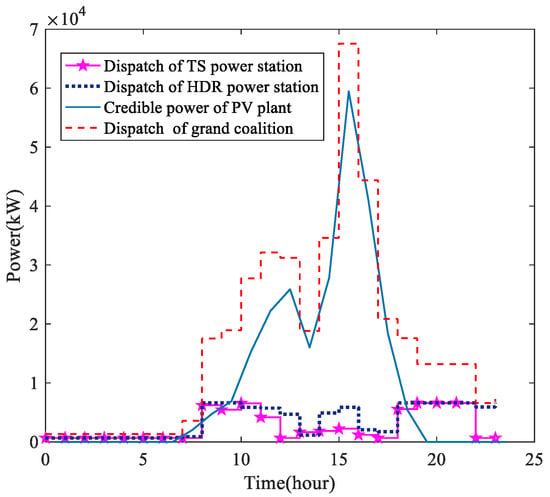
Figure 7.
The coordinated dispatching of HDR-TS-PV coalition.
4.3. Stability Analysis of Coalitions
In general, the payoff allocation of the coalition is not unique, and the set of all the stable allocations is defined as a core. In this paper, we adopt the minimum core (ε-core) method to analyze the stability of the coalitions, namely
where is the core set of the coalition and is the relaxation variable [44]. If the lower bound of is equal to zero, then the is non-empty before relaxation. Thus, the coalition is stable.
According to the overall payoff in Table 3, three players can form a stable grand coalition with a non-empty core through Equations (7) and (36). The stable allocation set of the grand coalition is shown in Figure 8.
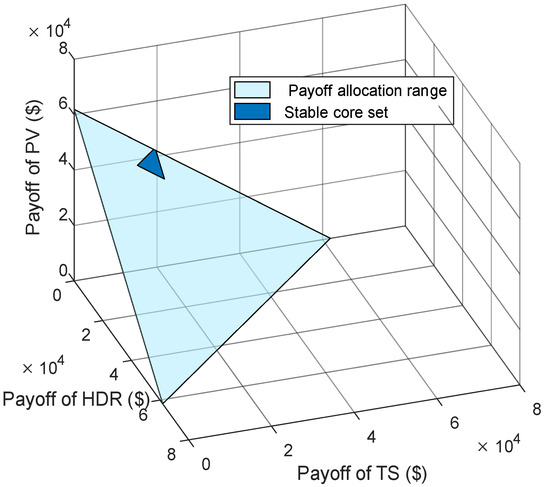
Figure 8.
Stable allocation set.
4.4. Allocation Strategy Based on Shapley Value
A stable coalition cannot guarantee the rationality of the payoff allocation. Therefore, it is necessary to study the fairness method of payoff allocation to provide a fair allocation strategy. The Shapley value is the fairest and most reasonable payoff allocation value among equal players [45]. It is based on marginal contributions and is widely used in cooperative games. Considering that there is no difference in status and weight between the HDR power station, the TS power station, and the PV plant, the Shapley value is adopted as the payoff allocation strategy. The simplified calculation [46] of the Shapley value can be expressed as
where is the number of elements in the subset and represents the remaining players in the sub-coalition after excluding player .
Table 4 shows the allocation results of the three players based on the Shapley value. Further analysis of the stability of this allocation strategy through Equation (37) shows that the allocation obtained by the Shapley value is stable, as shown in Figure 9.

Table 4.
Allocation based on Shapley value.
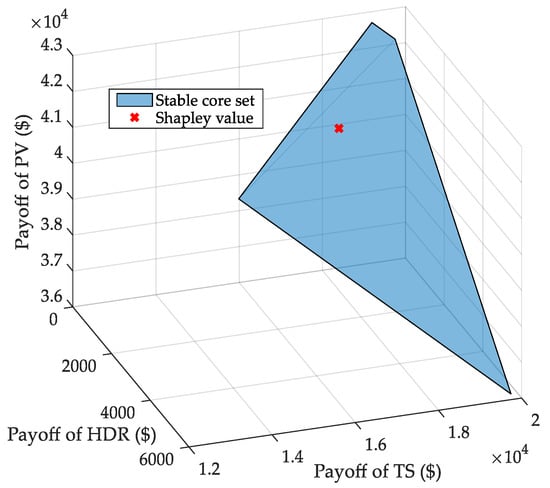
Figure 9.
Stability of the Shapley value.
4.5. Sensitivity Analysis
The extra profits of the grand coalition generated by the cooperative game are closely related to the allowed fluctuation rate that the power grid can tolerate and the penalty coefficient for abandoning loads. Therefore, based on the preceding section, the allowed fluctuation rate and penalty coefficient are varied to further analyze the role of the HDR, PV, and TS plants in the grand coalition.
Under the parameters in Table 1, the allowed fluctuation rates are set at 0%, 1%, 2%, and 3%. Simultaneously, when the penalty coefficients are 2, 3, 4, and 5, respectively, the payoff of the grand coalition and the extra profits obtained by each player are calculated. Figure 10 shows the relationship between the overall payoffs, the allowed fluctuation rate, and the penalty coefficient.
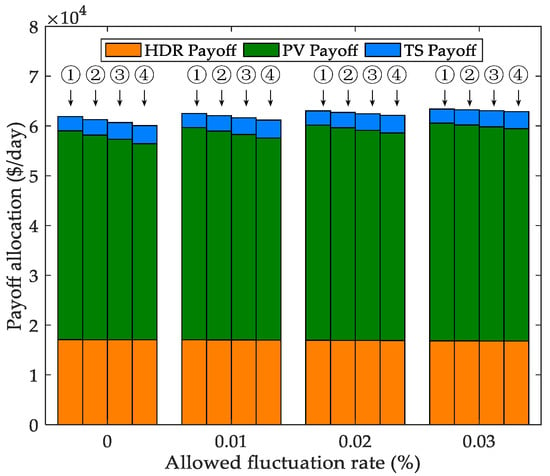
Figure 10.
The payoff allocation in the grand coalition.
In Figure 10, ①, ②, ③, and ④ correspond to the scenarios where the penalty coefficients are equal to 2, 3, 4, and 5, respectively. The overall payoff of the coalition increases with the increasing allowed fluctuation rate, mainly due to an increase in the grid-connected power of the PV plant and the penalty reduction. The overall payoff of the coalition decreases with an increase in the penalty coefficient, and the payoff of the PV plant is affected directly by the penalty coefficient. However, the payoff of the HDR power station is almost constant, reflecting the characteristics of stability and continuity of HDR resources. The TS power station is mainly responsible for creating profits and saving penalties by supporting the grid connection of the PV plant.
Figure 11 shows the changes in the allocation of the extra profits to the HDR, PV, and TS power stations with the change in the allowed fluctuation rate. The overall extra profits decrease with an increase in the allowed fluctuation rate, which indicates that the extra profits of the coalition decrease with an increase in the ability of the power grid to withstand power fluctuation. These extra profits are mainly caused by the curtailment of energy and penalty cost generated by the PV plant. Simultaneously, the extra profits of the HDR power station do not change with the penalty coefficient changes and are not sensitive to the allowed fluctuation rates, indicating that the extra profit of the HDR power station is obtained by the peak regulation of geothermal energy, which is not affected by the PV plant.
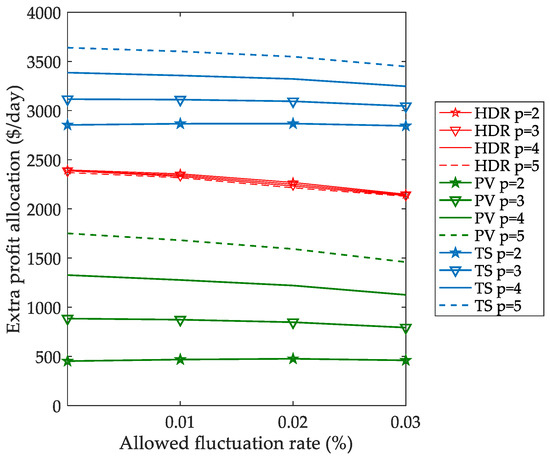
Figure 11.
The extra profits allocation of HDR-TS-PV coalition.
The variation trends of the extra profits obtained by the PV and TS power stations are similar. The higher the penalty coefficient, the more the extra profits that are allocated. The relationship between the penalty coefficient and extra profits indicates that the TS power station is the main contributor that supports the grid connection of the PV station, realizes the value of the surplus PV power, and reduces the penalty.
Analysis of Figure 10 and Figure 11 shows that the extra profits in the grand coalition, generated by the cooperative game, result from three factors. First, owing to the peak-regulating effect of the TS power station, the HDR generation period shifts from the low TOU price period to the high TOU price period. Second, through the flexible operation of the HDR and the TS power stations, a greater capacity of the PV station can track the dispatching curve, thus reducing the penalty. Third, the curtailed power and geothermal energy are stored and utilized by the TS power station.
5. Discussion
Further analysis of payoff and extra profits was carried out to reveal the role of the players in the hybrid power system and the source of the extra profits. It can be seen from Table 2 that under the TOU price given in Figure 3, the arbitrage operation of the TS power station cannot be profitable due to the low power generation efficiency of the ORC generator. As a result, the TS power station can only benefit by abandoning heat and electricity with zero marginal cost through cooperating with HDR power station or PV plant. Therefore, its dispatching strategy is to always adopt a minimum generation operation in low TOU price periods and PV generation periods in order to store as much as possible the waste heat and surplus power, as shown in Figure 7. It can be seen from the actual operation shown in Figure 6 that under this operating strategy, the TS power station can play a peak shaving role by storing geothermal energy, which realizes its payoff and makes the geothermal energy mainly generated in high TOU price periods, thereby creating extra profits. Simultaneously, the TS power station can recover the waste heat of the HDR power station when the down reserve is provided to the PV plant, further improving the system profits. As can be seen from the allocation results in Table 4, the extra profits of the TS power station accounted for 50.04% of the total extra profits. This result further shows that the TS power station has the most considerable marginal contribution to the extra profits, reflecting the decisive role of the TS power station in the game relationship.
Due to its operating characteristics, the HDR power station cannot cooperate with the PV plant without abandoning heat, so it cannot provide auxiliary services for the PV plant alone. Since the TS power station can directly store geothermal energy, it can help the HDR power station realize arbitrage. Table 3 shows that when the HDR power station and the TS power station cooperate, the payoff of the HDR-TS coalition increases by 8.04% relative to the non-cooperation operation, and the overall payoff of the grand coalition only increases by 1.95% relative to the HDR-TS coalition when the PV plant joins. The extra profits in Table 4 show that the HDR power station is allocated 42.02% of the overall extra profits. This result shows that the increased profits of the hybrid power system in the cooperative game mainly come from the peak shaving arbitrage of geothermal energy. Figure 10 and Figure 11 also show that the HDR power station is not affected by grid parameters and , which further clarifies that the payoff and extra profits of the HDR power station mainly come from its geothermal energy.
Table 3 shows that when the PV plant and the TS power station cooperate, the overall payoff of the hybrid system only increased by 1.12%. In the grand coalition, the extra profits of the PV plant accounted for only 7.94%. It can be seen that the contribution of the PV plant to the extra profits of the hybrid system is small. The main interest of PV plants participating in the coordinated dispatch of the hybrid power system is to increase the credible capacity and reduce the impact on the grid so as to obtain the priority of grid connection. This result is also reflected in Figure 10 and Figure 11. The increase in the allowed fluctuation rate and the penalty coefficient decrease indicates that the grid’s ability to absorb fluctuating power has increased. A strong power grid increases the non-cooperative payoff of the PV plant and decreases the cooperative extra profits, thereby reducing the willingness of the PV plant to cooperate.
Moreover, since the temperature of the geothermal reservoir is a critical parameter that restricts the operating performance of the HDR power station, we conducted a preliminary simulation on the influence of the temperature change on the overall payoff of the hybrid power system. According to previous research [38], when the temperature is 170 °C, the energy efficiency of ORC is 12.7%. Simulation with these parameters shows that when the temperature drops to 170 °C, the overall payoff of the hybrid power system is 54,285 $/day, a drop of 12.28%. The credible capacity of PV plants participating in cooperative games is reduced by 28.78%. The preliminary results indicate that after the HDR power station has been operating for about 10 years, the three players’ willingness to participate in the cooperative game will decrease. More in-depth research on the influence of more HDR power station parameters on the hybrid power system is needed in future research.
6. Conclusions
For the grid-connection requirements of large-scale PV plants, we first proposed the technical route of using HDR power stations to provide reserves for PV plants in this study. The operating characteristics of conventional HDR power stations were analyzed, and a scheme for using TS power stations to improve the operating flexibility of HDR power stations was proposed. In this study, a hybrid power system consisting of an HDR station, a TS station, and a PV plant was designed, and a coordinated dispatching method was provided based on game theory. First, taking HDR power station, TS power station, and PV plant as players, the non-cooperative game model and the characteristic function game model of the hybrid power system dispatching were established. The optimization of the dispatching models describes the decision-making processes of the players.
Consequently, the coordinated dispatching strategy of the players was obtained by calculating the optimal value of the payoff functions and the characteristic functions that can be transformed into linear optimization problems or mixed-integer linear optimization problems. The case analysis was based on actual data in the Gonghe Basin. The results show that only cooperation can maximize the overall payoff and the individual profits of the system. Due to heat loss, the HDR power station cannot form a coalition with the PV plant alone, reflecting the significant role of the TS power station in the system. Finally, the sensitivity analysis of the allowed fluctuation rate and the penalty coefficient shows that they significantly influence the overall payoff of the system and the operating strategies of each player. However, the profits of the HDR power station are not significantly affected by the two parameters, which reflects its stable characteristics. The main goal of PV plants in the cooperative game is to increase credible capacity and reduce the impact on the grid, and TS power station is the key to achieving extra profits for HDR power station and PV plant. This study provides an essential theoretical basis for developing power generation systems based on HDR geothermal energy in the Gonghe basin of Qinghai, China.
One limitation of this study is that the grid topology and capacity constraints are simplified when constructing the game dispatching model and calculating the payoff allocation of the hybrid power system. The influence of the grid structure on the hybrid power system will be further investigated in future studies.
Author Contributions
Conceptualization, Y.S. and X.Z.; Formal analysis, Y.S.; Funding acquisition, X.Z. and T.Z.; Methodology, Y.S., L.C. and S.M.; Project administration, S.M.; Software, Y.S.; Supervision, S.M.; Validation, X.C. and T.Z.; Writing—original draft, Y.S. and S.M.; Writing—review and editing, Y.S., X.Z. and X.C. All authors have read and agreed to the published version of the manuscript.
Funding
This research was funded by the Joint Fund Project of the National Natural Science Foundation of China (U1766203), the Basic Research Project of Qinghai Province (2020-ZJ-741).
Institutional Review Board Statement
Not applicable.
Informed Consent Statement
Not applicable.
Data Availability Statement
The data that support the findings of this study are available from the corresponding author, [L.C.], upon reasonable request.
Acknowledgments
The authors would like to thank Feng Liu and Wei Wei for very helpful discussions on the cooperative game, Xiaodai Xue and Tong Zhang for discussions on the HDR geothermal generator model, Zhongjie Guo and Jiayu Bai for suggestions on practical issues, Zhaojian Wang for discussions on reviewer’s comments.
Conflicts of Interest
The authors declare no conflict of interest.
References
- Cai, B.; Xue, Y.; Fan, Y.; Wen, Y.; Yang, X.; Yang, S.; Li, Z.; Wang, H. Optimization on Trans-regional Electricity Transmission Scale of China’s Western Renewable Energy Base: The case study of Qinghai Province. EDP Sci. 2020, 143, 02012. [Google Scholar] [CrossRef]
- Lu, S.-M. A global review of enhanced geothermal system (EGS). Renew. Sustain. Energy Rev. 2018, 81, 2902–2921. [Google Scholar] [CrossRef]
- Xu, T.; Liang, X.; Feng, B.; Jiang, Z. Geologic setting of the potential EGS site at the Gonghe basin, China: Suitability for re-search and demonstration of hot dry rock geothermal energy development. In Proceedings of the 44th Workshop on Geothermal Reservoir Engineering, Stanford, CA, USA, 11–13 February 2019; Stanford University: Stanford, CA, USA, 2019. [Google Scholar]
- Yan, X.; Yanguang, L.; Wang, G.; Lu, Y. Optimal injection rate of water in the Guide Basin hot dry rock mining project. Energy Explor. Exploit. 2019, 37, 721–735. [Google Scholar] [CrossRef]
- Nabernegg, S.; Bednar-Friedl, B.; Muñoz, P.; Titz, M.; Vogel, J. National Policies for Global Emission Reductions: Effectiveness of Carbon Emission Reductions in International Supply Chains. Ecol. Econ. 2019, 158, 146–157. [Google Scholar] [CrossRef]
- Breede, K.; Dzebisashvili, K.; Liu, X.; Falcone, G. A systematic review of enhanced (or engineered) geothermal systems: Past, present and future. Geotherm. Energy 2013, 1, 4. [Google Scholar] [CrossRef]
- Brown, D.; Du Teaux, R.; Kruger, P.; Swenson, D.; Yamaguchi, T. Fluid circulation and heat extraction from engineered geo-thermal reservoirs. Geothermics 1999, 28, 553–572. [Google Scholar] [CrossRef]
- Kumari, W.; Ranjith, P.; Perera, M.; Li, X.; Li, L.; Chen, B.; Isaka, B.A.; De Silva, V. Hydraulic fracturing under high temperature and pressure conditions with micro CT applications: Geothermal energy from hot dry rocks. Fuel 2018, 230, 138–154. [Google Scholar] [CrossRef]
- Zhang, Y.-J.; Li, Z.-W.; Guo, L.-L.; Gao, P.; Jin, X.-P.; Xu, T.-F. Electricity generation from enhanced geothermal systems by oilfield produced water circulating through reservoir stimulated by staged fracturing technology for horizontal wells: A case study in Xujiaweizi area in Daqing Oilfield, China. Energy 2014, 78, 788–805. [Google Scholar] [CrossRef]
- Quick, H.; Michael, J.; Huber, H.; Arslan, U. History of international geothermal power plants and geothermal projecTS in Germany. In Proceedings of the World Geothermal Congress 2010, Bali, Indonesia, 25–29 April 2010; pp. 25–29. [Google Scholar]
- Fallah, M.; Mahmoudi, S.M.S.; Yari, M.; Ghiasi, R.A. Advanced exergy analysis of the Kalina cycle applied for low temperature enhanced geothermal system. Energy Convers. Manag. 2016, 108, 190–201. [Google Scholar] [CrossRef]
- Fiaschi, D.; Manfrida, G.; Rogai, E.; Talluri, L. Exergoeconomic analysis and comparison between ORC and Kalina cycles to exploit low and medium-high temperature heat from two different geothermal sites. Energy Convers. Manag. 2017, 154, 503–516. [Google Scholar] [CrossRef]
- Guo, S.; Liu, Q.; Sun, J.; Jin, H. A review on the utilization of hybrid renewable energy. Renew. Sustain. Energy Rev. 2018, 91, 1121–1147. [Google Scholar] [CrossRef]
- Xu, T.; Zhang, N. Coordinated Operation of Concentrated Solar Power and Wind Resources for the Provision of Energy and Reserve Services. IEEE Trans. Power Syst. 2016, 32, 1260–1271. [Google Scholar] [CrossRef]
- Peng, C.; Xie, P.; Pan, L.; Yu, R. Flexible Robust Optimization Dispatch for Hybrid Wind/Photovoltaic/Hydro/Thermal Power System. IEEE Trans. Smart Grid 2015, 7, 751–762. [Google Scholar] [CrossRef]
- Dabbaghjamanesh, M.; Mehraeen, S.; Kavousifard, A.; Igder, M.A. Effective dispatching operation of coordinated and un-coordinated wind-hydro and pumped-storage in generation units with modified JAYA algorithm. In Proceedings of the IEEE Industry Applications Society Annual Meeting 2017, Cincinnati, OH, USA, 1–5 October 2017; pp. 1–8. [Google Scholar]
- Cebulla, F.; Naegler, T.; Pohl, M. Electrical energy storage in highly renewable European energy systems: Capacity require-ments, spatial distribution, and storage dispatch. J. Energy Storage 2017, 14, 211–223. [Google Scholar] [CrossRef]
- Nottrott, A.; Kleissl, J.; Washom, B. Energy dispatch schedule optimization and cost benefit analysis for grid-connected, photovoltaic-battery storage systems. Renew. Energy 2013, 55, 230–240. [Google Scholar] [CrossRef]
- Aziz, A.S.; Tajuddin, M.F.N.; Adzman, M.R.; Ramli, M.A.; Mekhilef, S. Energy Management and Optimization of a PV/Diesel/Battery Hybrid Energy System Using a Combined Dispatch Strategy. Sustainability 2019, 11, 683. [Google Scholar] [CrossRef]
- Diorio, N.; Denholm, P.; Hobbs, W.B. A model for evaluating the configuration and dispatch of PV plus battery power plants. Appl. Energy 2020, 262, 114465. [Google Scholar] [CrossRef]
- Moga, D.; Petreuş, D.; Muresan, V.; Stroia, N.; Cosovici, G. Optimal generation scheduling in islanded microgrids. IFAC PapersOnLine 2016, 49, 135–139. [Google Scholar] [CrossRef]
- Zare, V. A comparative thermodynamic analysis of two tri-generation systems utilizing low-grade geothermal energy. Energy Convers. Manag. 2016, 118, 264–274. [Google Scholar] [CrossRef]
- Si, Y.; Chen, L.; Zhang, X.; Mei, S. Capacity optimization of micro energy network with hot dry rock enhanced geothermal system. Power Syst. Technol. 2020, 44, 1603–1611. [Google Scholar]
- Li, T.; Jia, Y.; Wang, J.; Meng, N.; Liu, Q.; Qin, H. Energy, economic and environmental evaluation of a novel combined cooling and power system characterized by temperature and humidity independent control. Energy Convers. Manag. 2020, 215, 112929. [Google Scholar] [CrossRef]
- Abapour, S.; Nazari-Heris, M.; Mohammadi-Ivatloo, B.; Tarafdar-Hagh, M. Game Theory Approaches for the Solution of Power System Problems: A Comprehensive Review. Arch. Comput. Methods Eng. 2018, 27, 81–103. [Google Scholar] [CrossRef]
- He, J.; Li, Y.; Li, H.; Tong, H.; Yuan, Z.; Yang, X.; Huang, W. Application of Game Theory in Integrated Energy System Systems: A Review. IEEE Access 2020, 8, 93380–93397. [Google Scholar] [CrossRef]
- Mei, S.; Wang, Y.; Liu, F.; Zhang, X.; Sun, Z. Game Approaches for Hybrid Power System Planning. IEEE Trans. Sustain. Energy 2012, 3, 506–517. [Google Scholar] [CrossRef]
- Yuan, W.; Huang, J.; Zhang, Y.J.A. Competitive Charging Station Pricing for Plug-In Electric Vehicles. IEEE Trans. Smart Grid 2015, 8, 1–13. [Google Scholar] [CrossRef]
- Wang, Z.; Liu, F.; Chen, L.; Mei, S. Distributed economic automatic generation control: A game theoretic perspective. In Proceedings of the 2015 IEEE Power & Energy Society General Meeting, Denver, CO, USA, 26–30 July 2015; pp. 1–5. [Google Scholar]
- Yang, G.; Fu, J.; Wang, D.; Liu, Y.; Luo, H. Study on Non-Cooperative Game Dispatching of Regional Power System with Wind-Thermal-Pumped Storage Power. In Proceedings of the 2017 IEEE International Conference on Energy Internet (ICEI), Beijing, China, 17–21 April 2017; pp. 24–29. [Google Scholar]
- Yuan, T.; Ma, T.; Sun, Y.; Chen, N.; Gao, B. Game-Based Generation Scheduling Optimization for Power plants Considering Long-Distance Consumption of Wind-Solar-Thermal Hybrid Systems. Energies 2017, 10, 1260. [Google Scholar] [CrossRef]
- Kristiansen, M.; Korpås, M.; Svendsen, H.G. A generic framework for power system flexibility analysis using cooperative game theory. Appl. Energy 2018, 212, 223–232. [Google Scholar] [CrossRef]
- Du, Y.; Wang, Z.; Liu, G.; Chen, X.; Yuan, H.; Wei, Y.; Li, F. A cooperative game approach for coordinating multi-microgrid operation within distribution systems. Appl. Energy 2018, 222, 383–395. [Google Scholar] [CrossRef]
- Zhigang, W.; Minru, X.; HaiXiao, Z.; Yao, W.; Zehua, Y.; Ai, W.; Jiwu, L.; Zheng, S.; Shuting, L. Research on Profit Distribution Strategy of Electric Vehicles Absorbing Wind Power Based on Cooperative Game. In Proceedings of the 2018 2nd IEEE Conference on Energy Internet and Energy System Integration (EI2), Beijing, China, 20–22 October 2018; pp. 1–6. [Google Scholar]
- Liu, J.; He, D. Profit Allocation of Hybrid Power System Planning in Energy Internet: A Cooperative Game Study. Sustainability 2018, 10, 388. [Google Scholar] [CrossRef]
- Zhang, Y.; Zhao, G.F. A global review of deep geothermal energy exploration: From a view of rock mechanics and engineer-ing. Geomech. Geophys. Geo-Energy Geo-Resour. 2020, 6, 4. [Google Scholar] [CrossRef]
- Aliyu, M.D.; Archer, R.A. Thermo-hydro-mechanical model of multifracture HDR geothermal reservoirs. Geotherm. Resour. Counc. Trans. 2020, 44, 1–28. [Google Scholar]
- Zhang, X.; Zhang, T.; Xue, X.; Si, Y.; Zhang, X.; Mei, S. A comparative thermodynamic analysis of Kalina and organic Ran-kine cycles for hot dry rock: A prospect study in the Gonghe Basin. Front. Energy 2020, 14, 889–900. [Google Scholar]
- Zhang, S.; Cheng, H.; Zhang, L.; Bazargan, M.; Yao, L. Probabilistic evaluation of available load supply capability for the distribution system. IEEE Trans. Power Syst. 2013, 28, 215–3225. [Google Scholar] [CrossRef]
- Si, Y.; Zhang, X.; Mei, S.; Fan, Y.; Zhang, T.; Xue, X. Preliminary study on HDR power generation technology and application of HDR in Gonghe, Qinghai Province. Glob. Energy Interconnect. 2018, 1, 322–329. [Google Scholar]
- Zhao, X.; Zeng, Z.; Wu, Y.; He, R.; Wu, Q.; Zhang, S. Interpretation of gravity and magnetic data on the hot dry rocks (HDR) delineation for the enhanced geothermal system (EGS) in Gonghe town, China. Environ. Earth Sci. 2020, 79, 1–13. [Google Scholar] [CrossRef]
- Shu, Z.; Jirutitijaroen, P.; Leite da Silva, A.M.; Singh, C. Accelerated state evaluation and Latin hypercube sequential sam-pling for composite system reliability assessment. IEEE Trans. Power Syst. 2014, 29, 1692–1700. [Google Scholar] [CrossRef]
- Liu, D.C.; Ma, H.R.; Wang, B.; Gao, W.; Wang, J.; Yan, B. Operation optimization of regional integrated energy system with CCHP and energy storage system. Autom. Electr. Power Syst. 2018, 42, 113–120. [Google Scholar]
- Mei, S.; Wei, W.; Liu, F. On engineering game theory with its application in power systems. Control. Theory Technol. 2017, 15, 1–12. [Google Scholar] [CrossRef]
- Fudenberg, D.; Tirole, J. Game Theory; MIT Press: Cambridge, MA, USA, 1992; pp. 436–444. [Google Scholar]
- Hart, S.; Mas-Colell, A. Cooperation: Game-Theoretic Approaches; Springer: New York, NY, USA, 1997; pp. 43–51. [Google Scholar]
Publisher’s Note: MDPI stays neutral with regard to jurisdictional claims in published maps and institutional affiliations. |
© 2021 by the authors. Licensee MDPI, Basel, Switzerland. This article is an open access article distributed under the terms and conditions of the Creative Commons Attribution (CC BY) license (http://creativecommons.org/licenses/by/4.0/).